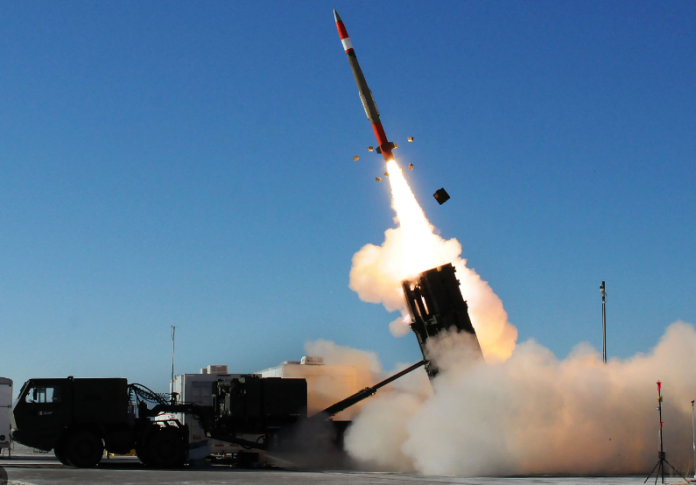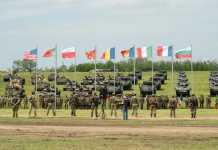The U.S. surface fleet is as essential to defeating China in a West Pacific war as it is vulnerable to the higher end of adversary capabilities. A combination of solutions is needed, both in the short term and over time, to ensure the fleet’s operational capacity. To reinvest in a resilient, survivable fleet, the Navy should concurrently acquire proposed new counter-hypersonic capabilities like the Compact Agile Interceptor and gain a multi-mission advantage by procuring the navalized Patriot PAC-3 MSE, particularly in light of defense industrial base limitations and the need to ensure the U.S. surface fleet retains multiple capacities.
The U.S. Navy is in the midst of a long-term readiness crisis that began around a decade ago. A combination of budget cuts, bureaucratic bickering, and a dearth of political skill has stressed the Navy perilously. A fleet too small for its current requirements is asked to take the lead in deterring or perhaps contesting a near-peer competitor, the Chinese Communist Party’s steadily advancing People’s Liberation Army (PLA).
The PLA understands the fundamentals of America’s way of war. It seeks to deny the U.S. access to the First Island Chain, the area of most intense combat, and keep U.S. forces at a distance as it applies power regionally. For absent heavy American assets, the U.S.’ regional allies – not only Taiwan, but also Japan, the Philippines, and South Korea – will be isolated and overwhelmed.
To this end, the PLA fields a diverse missile arsenal meant to hold high-value U.S. assets at risk within 600-to-1,000 kilometers of the First Island Chain. The PLA needs a six to eight-week window within which U.S. heavy units are removed from the fight.
Ironically, the U.S. heavy units that the PLA regards as a threat are also those forces that the military’s most forthright “Transformation” critics have sought to eliminate. In a major war, victory or defeat will stem from the U.S.’ ability to apply heavy combat power, delivered almost exclusively by aircraft carrier strike wings and long-range bombers. These are the PLA’s targets.
The opening phase of an Indo-Pacific War, then, is likely to involve most of China’s high-end missiles attacking U.S. carriers, ports, and air bases. Naval assets are of particular importance. Guam will be saturated, and U.S. bases in Japan will be targets. But the U.S. Air Force’s heavy bombers, both the stealthy B-2 and the non-stealthy B-1 and B-52 have long enough range to operate, if needed, from airfields in the U.S., let alone in the eastern Pacific, particularly if refueled and, for the B-1 and B-52, equipped with longer-range standoff hypersonic missiles. The U.S. Navy’s carrier air wings would provide the on-the-spot, responsive combat power needed to break down the PLA’s strike forces and influence the First Island Chain fight.
Surviving this bombardment requires a combination of new tactics and technologies. In the future, better communications and a renewed emphasis on Emissions Control and dispersion will increase the PLA’s scouting problem, forcing the Chinese to expend more assets to find U.S. forces. But once found, U.S. forces must survive bombardments. This is particularly relevant when U.S. carrier strike groups make short dashes into the Chinese reconnaissance-strike bubble to deploy their aircraft and hit high-value scouting and strike nodes. Effective dispersion will increase the time from penetration to detection significantly, as the U.S. learned during the Cold War. But at some point, a physical defense mechanism against missiles is crucial.
The Navy faces three overlapping questions when it comes to its ability to intercept enemy missiles. From a technical viewpoint, the Navy’s AEGIS combat system can combat hypersonics and is more than capable of handling cruise missiles.
But the issue is one off scale. The PLA will salvo an enormous number of missiles concurrently, attempting to have these complex missile raids reach their targets from multiple directions, and conducting several raids in a short time-span. The U.S. Navy’s guided-missile destroyers have only so many missiles, and these will be depleted in each raid. Upon their depletion, surface combatants will need to rearm, either by returning to port or, ideally, at sea.
Yet all the U.S. Navy’s interceptors are relatively restricted in supply. The SM2, the backbone of the air defense system, had a cold production line until 2017. Its producer, Raytheon, only restarted production because of a bundled international buy, and the line remains relatively small compared to what the Navy would need in wartime. The SM6, the most advanced, multi-mission pillar of the Navy’s interceptor arsenal, has a more robust production line. But it remains small: from when it reached full-rate production in 2013 to 2022, Raytheon delivered only 500 missiles, for an average of around 50 missiles per year. Ship loadouts vary by mission, but an air-defense focused Arleigh Burke destroyer protecting a carrier will deploy with around half of its missile complement – around 100 missiles – as interceptors. A cold SM2 line necessitates swapping these older missiles with more SM6s, but at current production rates, the Navy could equip at best ten Arleigh Burkes with one air-defense complement.
Slim margins and greater combat risks can be accepted in peacetime, particularly when the Navy has years to decades of warning prior to a threat’s maturation. This is unacceptable during a pre-war situation, the one in which we now find ourselves.
The risk is, then, that even if the U.S. Navy’s air-defense ships can blunt an initial Chinese missile wave, the Navy will struggle to rearm these ships. Expanding SM6 production and restarting a domestic SM2 line are both reasonable moves. But this is obviously insufficient for the Navy’s current needs. Long-term, new programs like the Navy’s Compact Agile Interceptor (CAI) will help – the CAI is meant to deliver a low-cost, small missile that can provide the volume needed to defend against saturation raids. Yet the program remains notional, as does the research into these weapons.
The solution is to turn to a proven weapon with a proven supply line. The PAC-3 Missile Segment Enhancement (MSE), an improved version of the PAC-3 missile already in service with the U.S. military and U.S. allies, could be used to increase the pool of available missiles. The PAC-3 MSE is capable of engaging hypersonics, as its traditional PAC-3 cousin has reportedly demonstrated in Ukraine. The weapon would need only light modification to be fielded on warships. Apart from that, the already-hot production line could accelerate a bona fide high-end interceptor’s deployment to the fleet. Lockheed Martin, the PAC-3’s producer, traditionally made around 500 missiles per year. But that was before the avalanche of demand signals that the Ukraine War prompted. Now that a variety of U.S. allies, the U.S. military, and the Ukrainians want the missile at larger scale, it is reasonable to double-down on a production line that will already be greatly enhanced.
Despite the perplexity of constant internecine bureaucratic wrangling over weapons systems—and their funding—within the Defense Department, there is agreement that the design and production of new or modified weapons must accelerate significantly to sustain American military superiority. History demonstrates the difficulties of American weapons system development. The Navy needs proven weapons: it cannot bet on a decade-long development process that costs well over $1 billion, and that is likely to overrun cost estimates. The Navy’s ability to intercept major cruise and hypersonic missile raids using currently available technology is a test of how quickly we can adapt. It could also play an outsized role in an Indo-Pacific conflict.
Seth Cropsey is the founder and president of Yorktown Institute. He served as a naval officer and as deputy Undersecretary of the Navy and is the author of Mayday and Seablindness.





